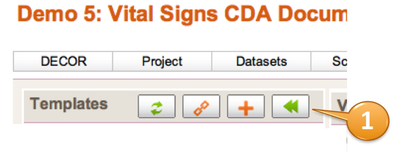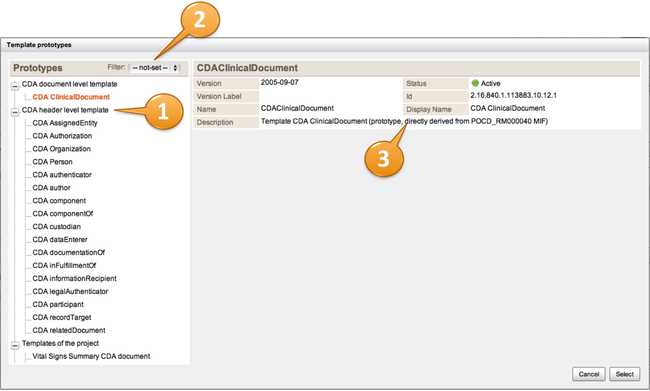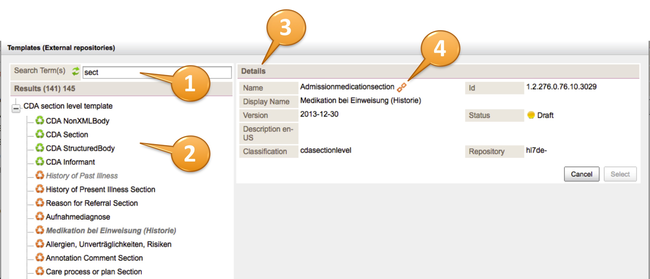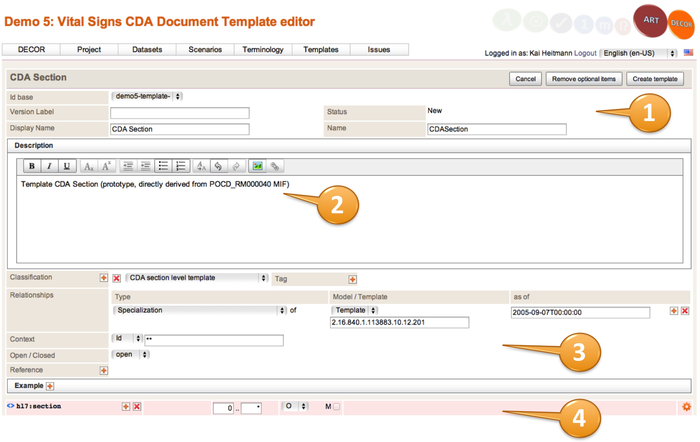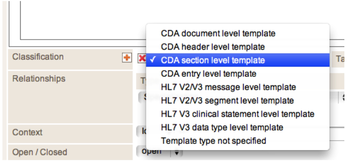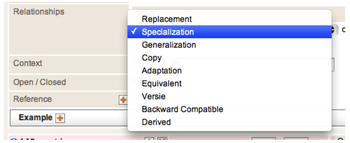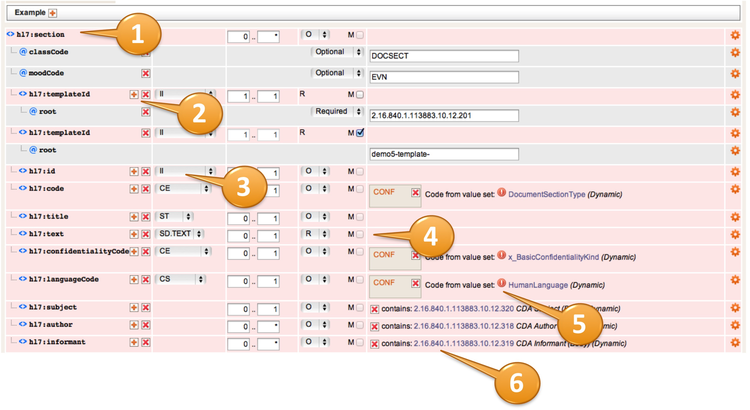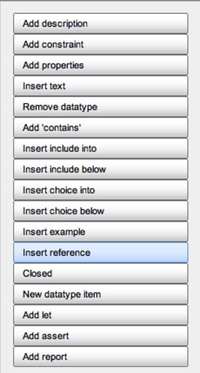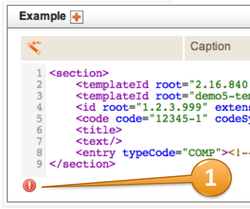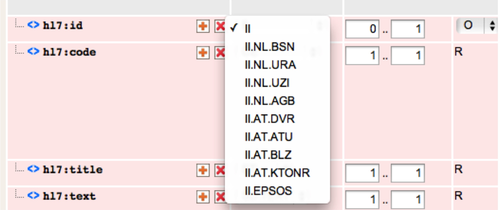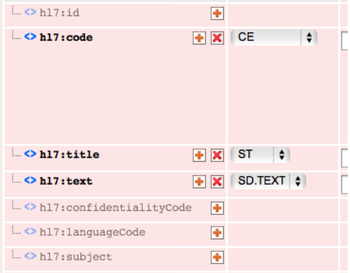Difference between revisions of "ART Template Editor"
(→Design Body) |
(→Add description) |
||
| Line 73: | Line 73: | ||
In detail most of the actions are self explanatory, only some of them need further explanation. | In detail most of the actions are self explanatory, only some of them need further explanation. | ||
===== Add description===== | ===== Add description===== | ||
| − | + | ===== Add constraint===== | |
| − | + | A textual further constraint statement on the item | |
| − | + | ===== Add properties===== | |
| − | + | A way to add additional properties to certain items, e.g. units or ranges on physical quantity items | |
| − | + | ===== Insert text | |
| + | ===== Remove datatype | ||
| + | ===== Add 'contains'===== | ||
| + | Allows to add a containment of another template, a selection dialog is shown | ||
[[File:TemplateEditor-Containment.png|250px| Containment.png]] | [[File:TemplateEditor-Containment.png|250px| Containment.png]] | ||
| − | + | ===== Insert 'include' into===== | |
| − | + | Adds an inclusion of another template into the current item, a selection dialog is shown | |
| − | + | ===== Insert 'include' below===== | |
| − | + | Adds an inclusion of another template below the current item, a selection dialog is shown | |
| + | ===== Insert 'choice' into, adds a choice into the current item===== | ||
| + | ===== Insert 'choice' below, adds a choice below the current item===== | ||
| + | |||
=====Insert example===== | =====Insert example===== | ||
[[File:TemplateEditor-Example.png|250px|Example]] | [[File:TemplateEditor-Example.png|250px|Example]] | ||
Revision as of 16:22, 5 August 2014
Contents
- 1 Template Editor Overview
- 1.1 Creating a new template
- 1.2 Creating a new version of an existing template
- 1.3 Creating a link to a template that resides in a BBR
- 1.4 Editing a template
- 1.4.1 Metadata
- 1.4.2 Design Body
- 1.4.2.1 Add description
- 1.4.2.2 Add constraint
- 1.4.2.3 Add properties
- 1.4.2.4 Add 'contains'
- 1.4.2.5 Insert 'include' into
- 1.4.2.6 Insert 'include' below
- 1.4.2.7 Insert 'choice' into, adds a choice into the current item
- 1.4.2.8 Insert 'choice' below, adds a choice below the current item
- 1.4.2.9 Insert example
- 1.4.3 Saving the template, locks
Template Editor Overview
Starting the template editor is done from the ART Template Viewer or the ART Template Associations forms. From those forms you either start a completely new template, create a new version of an existing template, or edit a template. These options are handed as parameters to the Template Editor.
You can only work with the template editor if you are a designated project author.
Creating a new template
On the left hand side of the template viewer you'll find (up to) four buttons as shown in (1).
Click the ![]() button in the Template Viewer. The template editor will open and present a dialog with prototypes to base your new template on. These are taken from the building block repositories referenced in the project.
button in the Template Viewer. The template editor will open and present a dialog with prototypes to base your new template on. These are taken from the building block repositories referenced in the project.
The prototypes are alphabetically ordered and grouped by classification (1). You can set a filter, e.g. to show only templates of a specific type or the templates of your own project only (2). For all templates you may inspect the meta data (3). Click the prototype you need e.g. CDA Section and click the Select button.
From here, editing follows the same pattern as editing an existing template using the rules for a specialization of a template based on that prototype. See section about editing a template.
 | Please note that you need a reference to one of the prototype building block repository (BBR) in your project in order to see prototypes. The simplest way to do so is to add a BBR reference in your project, see Reference a building block repository. A list of prototype BBRs can be found here. |
Creating a new version of an existing template
When a template has reached the status 'Active', you can no longer alter it. What you can do is create a new version of it. The Template Viewer will present you with a choice when you click the Edit button on an active template
When you choose new version with the same id, it means that any dynamic binding to the selected template will now point to this new version. When you choose new version with different id, no existing bindings to templates are affected.
The Template Editor opens. From here, editing follows the same pattern as editing an existing template using the rules for an adaptation of a template based on that prototype. See section about editing a template.
Creating a link to a template that resides in a BBR
Click the ![]() button in the Template Viewer. The template repository browser window will open and present you a dialog with templates that reside in all accessible repositories. These are taken from the building block repositories mentioned in the project.
button in the Template Viewer. The template repository browser window will open and present you a dialog with templates that reside in all accessible repositories. These are taken from the building block repositories mentioned in the project.
You can enter search terms in the search field (1) and the templates matching the criteria are shown (2) with their names, effective dates, status codes and an abbreviation of the repository they reside. Some meta data details are shown also (3).
Once you selected a template from a repository the template is added to your project as a reference. It act as if it was a template in your own project but in fact is "borrowed" from the repository whenever it is used (visualized, used design of other templates, used for schematron generation etc.). In order to indicate that a template is referenced from a repository rather than a being a project template, a white circle symbol is shown to the left of the template name (instead of a status color as it is shown for templates "owned" by the project).
If you display a template that resides in a repository you have the option to edit that template (and by editing it you make a copy to your own project), or to delete the reference to that template. The options are offered through the button list.
Editing a template
Consider that a template in the editor is one potentially long page that allows editing the meta data like name, display name (1), description (2), classification, reference (3), etc. and the body like example, elements, attributes, choices, includes and their properties (starting at 4).
Metadata
You can edit the metadata, most of the meta data editing is filling out text and selecting options from the drop down menus. When you have selected a template from a prototype list then you typically have already set a classification for that template, otherwise you can select one.
You can add a relationship to another template or model easily.
Design Body
The design body of a template shows all information needed:
- a hierarchical list of elements and attributes (1)
- tiny little buttons to add or delete items (2)
- a popup menu offering you all possible data types in that context (3)
- cardinality fields to specify minimum and maximum multiplicity as well as the conformance and whether an item is mandatory, denoted as M (4)
- further conformance statements like value set bindings (5) or containments (6).
When you get to the body of the template you'll notice an action button ![]() to the far right with context sensitive options. When you click on the action button a context dependent dialog (see left) appears).
When you are working on a specialization for example, you will not get the option of creating new elements that are now part of the prototype. On datatypes you get to option to add attributes/elements that are part of that particular datatype.
to the far right with context sensitive options. When you click on the action button a context dependent dialog (see left) appears).
When you are working on a specialization for example, you will not get the option of creating new elements that are now part of the prototype. On datatypes you get to option to add attributes/elements that are part of that particular datatype.
In detail most of the actions are self explanatory, only some of them need further explanation.
Add description
Add constraint
A textual further constraint statement on the item
Add properties
A way to add additional properties to certain items, e.g. units or ranges on physical quantity items ===== Insert text ===== Remove datatype
Add 'contains'
Allows to add a containment of another template, a selection dialog is shown
![]()
Insert 'include' into
Adds an inclusion of another template into the current item, a selection dialog is shown
Insert 'include' below
Adds an inclusion of another template below the current item, a selection dialog is shown
Insert 'choice' into, adds a choice into the current item
Insert 'choice' below, adds a choice below the current item
Insert example
- Insert reference, adds a reference to the item
- Closed, makes this element defined as closed instead of open
- New datatype item
- Add let, adds a new raw schematron let statement
- Add assert, adds a new raw schematron assert statement
- Add report, adds a new raw schematron report statement
- Add fixed code, adds a fixed code to a coded element or attribute
- Add vocabulary, adds a binding to a value set
If a certain datatype is specializable into another datatypes or flavors thereof you may select this from the datatype drop menu. In the following figure, there is a flavor II.BSN (Dutch citizen service number) and a flavor II.EPSOS for the main datatype II.
Please note that if you edit template based on prototypes, the underlying prototype model is always transparently present. Not selected items are shown grayed-out, but you may add items from the prototype at any time by simply click on the add button, or delete items by clicking the minus button.
Saving the template, locks
Saving the template currently closes the Template Editor so intermediate saving and continue work is not possible. However, ART locks the template while you are working on it if you are editing an existing template. If you accidentally have a template locked and want to unlock is go to the Project Tab Status and in the dialog all locked artifacts are shown (and can be deleted).
